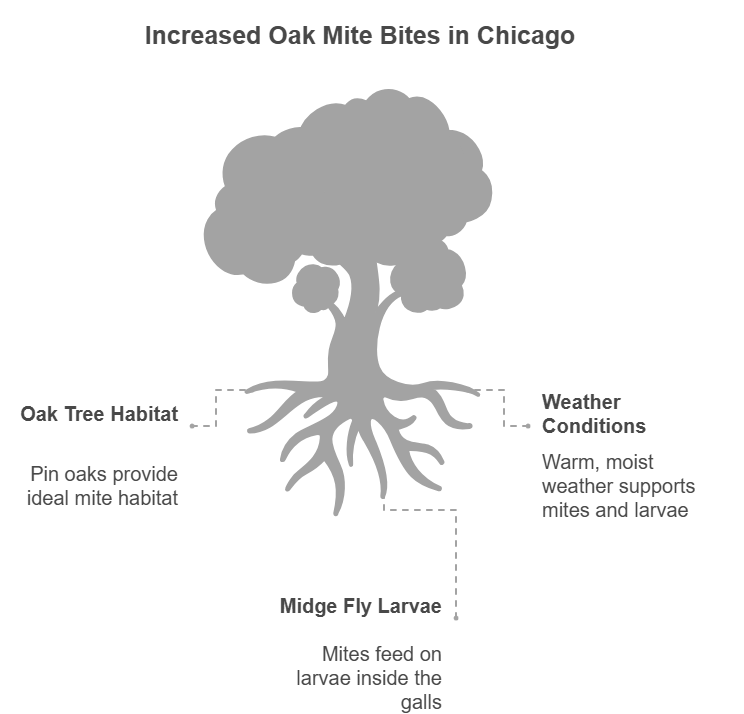


As summer transitions into fall, many Chicago residents start to notice an unsettling pattern, like itchy, red bites that seem to appear out of nowhere. These tiny, irritating welts often spark confusion, as they’re commonly mistaken for mosquito or bedbug bites. But the true culprit often lurks overhead — oak mites.
While they’re nearly invisible to the naked eye, oak mites have become a seasonal nuisance in Chicago, particularly during late summer and fall. Knowing what they are and how to protect yourself is the first step to staying comfortable and bite-free.
Explore the sneaky world of oak mites and learn how to stay itch-free.
Oak mites, also known as pyemotes, are microscopic parasitic mites that feed on the larvae of other insects, particularly the midge fly. These mites thrive in oak trees, especially pin oaks, where they breed inside structures called leaf galls, which form when midge flies lay their eggs in the leaves.
Once the mites consume the insect larvae, they are dislodged from the trees by wind or by simply falling to the ground. Unfortunately, that’s when they become a problem for humans.
Despite being so small that they’re barely visible, oak mites can deliver a noticeable and irritating bite, typically without you even realizing it at the time.
Chicago is home to thousands of oak trees, many of which are pin oaks that create the perfect habitat for oak mite infestations. These mites become particularly active in late summer and fall, coinciding with the time when midge fly larvae are present inside the galls.
The city's warm summers, followed by cooler, moist autumn conditions, are ideal for supporting both the insect larvae and the oak mites that feed on them. Add in breezy days or a walk under a tree-lined sidewalk, and it’s easy to encounter oak mites without knowing it.
In recent years, residents have increasingly reported mysterious bite outbreaks, raising public concern and prompting more attention to oak mite infestations throughout Chicago neighborhoods.

Unlike mosquitoes, oak mites don’t seek out humans to bite. Instead, they fall from infested trees or are carried by the wind. When they land on skin, especially around the neck, arms, and upper body, they can bite if trapped between skin and clothing.
What makes oak mite bites particularly frustrating is the delay in symptoms. You might not feel the bite when it happens, but within 10–12 hours, you could develop small, itchy red bumps, sometimes with a central blister or rash-like appearance.
Common hotspots for exposure include parks, sidewalks lined with oak trees, schoolyards, and backyards, especially during the peak months from August through October.
For more prevention tips, please read this blog - Preventing Oak Mite Bites: Tips to Stay Bite-Free This Season
Most oak mite bites, though itchy and uncomfortable, clear up within a few days with over-the-counter treatments like antihistamines or hydrocortisone cream.
However, you should consider seeking medical attention if:
Visiting an urgent care center can help rule out other skin conditions and provide stronger topical treatments if necessary for oak mite bites treatment.
Oak mites may be tiny, but their impact in Chicago each fall is anything but small. From itchy bites to growing infestations in city trees, these microscopic pests have become a familiar seasonal concern.
By staying alert during peak months, taking simple protective measures, and monitoring your surroundings, you can significantly reduce the risk of exposure. Whether you're strolling through your neighborhood park or relaxing in your backyard, a little awareness goes a long way in keeping those bites at bay.
As oak mite season stirs up discomfort, Metro Urgent Care is here to help you stay comfortable and protected. From bites to skin irritation, our providers offer quick relief and expert attention. Stop the itch before it worsens.
Contact us for prompt care today.
Oak mite bites usually appear as small, red, itchy welts, often with a raised center or blister. They typically show up in clusters, especially on the neck, arms, and upper body, and symptoms often appear 8–12 hours after exposure.
Oak mites thrive in pin oak trees, which are widespread across Chicago. They’re most often encountered in parks, backyards, sidewalks, and neighborhoods with mature oak trees, especially in late summer through early fall.
Most bites heal within a few days to a week. Itching and redness may linger, but over-the-counter antihistamines or hydrocortisone creams usually provide relief. If symptoms worsen or persist, a medical visit is recommended.
Oak mites don’t live or reproduce indoors. While they may land on your skin or clothing outdoors, they don’t infest homes. Showering and changing clothes after being outside can help prevent bites.
Avoid standing or sitting under oak trees, especially in late summer and early fall. Wear long sleeves and hats in tree-heavy areas, and consult a tree care professional to manage heavily infested oaks on your property.